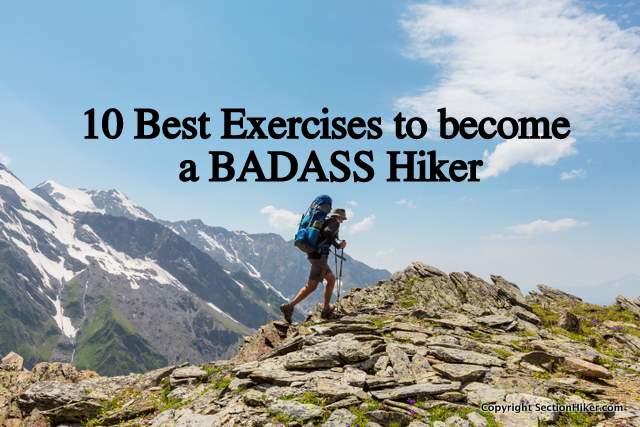 Badass hikers aren’t born, you have to train to become one. In addition to learning advanced hiking and backpacking skills, you need to train your butt and legs. Here are 10 functional exercises that work the big muscles and smaller stabilizers in your legs to help you become a badass hiker. They’re called functional exercises because they mimic natural movement, getting all of your muscles working together synergistically like they do when you hike. The exercises also incorporate various degrees of instability to help you develop better balance for walking on rough trails and terrain.
Badass hikers aren’t born, you have to train to become one. In addition to learning advanced hiking and backpacking skills, you need to train your butt and legs. Here are 10 functional exercises that work the big muscles and smaller stabilizers in your legs to help you become a badass hiker. They’re called functional exercises because they mimic natural movement, getting all of your muscles working together synergistically like they do when you hike. The exercises also incorporate various degrees of instability to help you develop better balance for walking on rough trails and terrain.
1. Weighted Glute Bridge on a Bench
The weighted glute bridge strengthens your butt and hamstrings, the two big leg muscles that put power into a hiker’s stride. If you don’t have a barbell you can get the same benefit using a medicine ball or a bag of flour as long as you hold it in the same position at the top of your legs. Keep your feet flat on the floor throughout this exercise and squeeze your buttocks at the top of the motion, holding for a few seconds before you lower your butt between reps. Keep the weight light and focus on having an explosive hip thrust on the way up, the squeeze in the middle, and then an easy release. Do 10-15 reps per set.
2. Goblet Squat
The Goblet squat is a safe squat that targets all of the big muscles in your legs, the glutes, hamstrings, and quadriceps. Grasp a kettlebell or dumbbell between your arms and slowly squat, keeping your thighs level with the floor without bouncing your knees at the bottom of the movement. To lift, power through your heels, squeezing your glutes together while keeping your head upright and the weight close to your chest. Do 10-15 reps per set.
3. Stability Ball Glute Bridge
The stability ball glute bridge is a bodyweight version of the glute bridge that uses the rolling, bouncy instability of a “stability” ball to help further activate your stabilizer muscles. This exercise is also a fantastic hamstring conditioner and one that will have you screaming. Take it slow and build up your endurance. Keep your hips off the floor between reps and squeeze your glutes at the top of the movement like before. Do 10-15 reps per set.
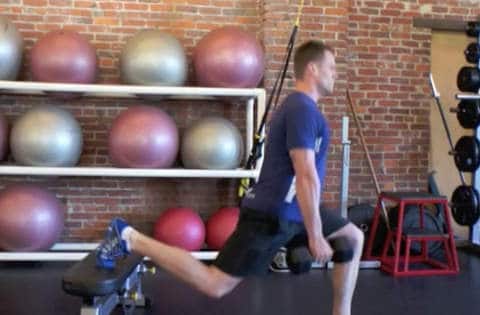
4. Split Dumbbell Lunge
Also known as the Bulgarian Split Squat, the split dumbbell lunge targets your quadriceps, the big muscles in the front of your thighs. The hardest part of learning this exercise is balance since one of your legs is on top of the bench behind you. If it helps, skip the dumbbells to start: one less thing to worry about. Place what will be your front foot about 3 foot-lengths in front of the bench, and place the top of your rear foot on the top—this is your starting position. Adjust the distance of your front foot from the bench as needed to make sure the front shin is about vertical in the bottom of the squat. With a controlled speed, bend at the front knee to lower yourself with an upright trunk until the rear knee lightly contacts the floor, then stand again pushing more through the front heel and the balls of the foot. Maintain the position of the front knee over the foot—don’t let it collapse inward or push it excessively outward. Do 5 reps on each side.

5. Bosu Squat
I love the Bosu since it’s easy to use for adding instability to just about any gym exercise. In the Bosu Squat, you do a standard front squat on the round side of the Bosu, working the hamstrings, quadriceps, glutes, and core muscles. Keep your head up and position your hands in front of you to maintain good form, keeping your thighs parallel to the floor. Keep the movement slow and don’t bounce your knees at the bottom of the squat. Do 10 reps.
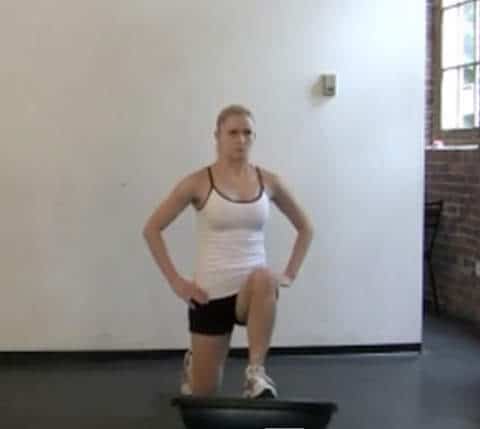
6. Reverse Lunge on a Bosu Ball
The reverse lunge on the Bosu requires core strength and targets the butt, thighs, and hips. It’s a great alternative to the forward lunge for those who are worried about a knee injury, as it does not allow your knees to extend beyond your toes. Put your front foot on top of the Bosu ball, while taking a big step backward with your other leg. Lower your hips to the floor until your front (right) knee forms a 90-degree angle. Push yourself up by straightening your front leg. Most of the strength should come from your front foot. Return your back foot to the starting position. Really focus on pressing the heel of your front foot into the Bosu ball as you lift up in order to engage your glutes to their full potential. Do 10 reps per side.

7. Single-Leg Dumbbell Press on a Bosu
The Single-Leg Dumbbell Press targets the hamstrings and the hip flexors while providing proprioceptive stimulus to the muscles of the ankle. If you’re having trouble integrating all the movements when you start, you can do this exercise without the Bosu ball until you want to ramp up the challenge.
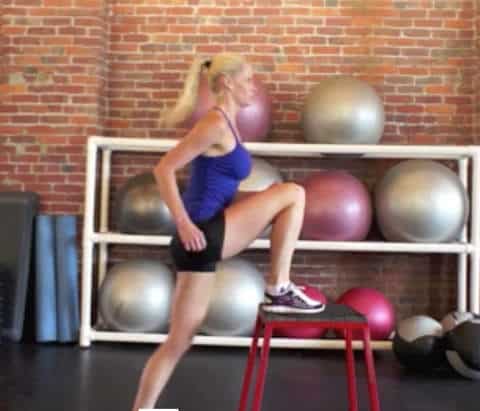
8. High Box Step Up
The High Box Step Up is a challenging exercise that targets the hamstrings, glutes, and quads. Extra instability is introduced when you increase the height of the step, forcing the stabilizer muscles to work together to keep you balanced. This exercise also provides a great hamstring stretch. Place one foot on a platform slightly higher than your knee and drive forward pressing down through your heel to lift your other leg. Then reverse the motion, controlling the descent to avoid jarring the leg on the way down. It’s harder than it looks. Do 10 reps for each leg.

9. Kettlebell Deadlift
The Kettlebell Deadlift provides a very safe way to perform the deadlift exercise. Grasp a kettlebell with both hands and squat down while keeping your thighs parallel to the floor and your head up. Drive down through your heels while straightening your legs and squeezing your glutes together at the top of the movement. Don’t bounce your knees on the descent. Do 10-15 reps.
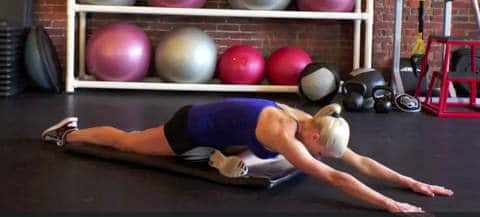
10.Walk Out Hip Stretch
If you’ve ever done yoga, you’ve probably done this exercise before, which is sometimes called the half pigeon. It’s a stretch for opening your hips and stretching your glutes, best done after a leg workout when your leg muscles are warm and loose. The key is not to force it, but to let gravity slowly loosen your muscles and drop your body to the floor. This may take weeks to accomplish, so use your arms to hold yourself up and modify the pose until you can fully stretch into it. Rather than keeping your knee open at a right angle, it can also help to close the knee to make the pose easier. Try holding it for 3 minutes on each side.
Recommended Warm-Ups
Before you do any of these exercises, you’re going to want to warm up your leg muscles. I recommend doing 30 minutes of leg-intensive cardio including running, a stair master or stair mill, or a rowing machine.
Frequency and Repetition
The 10 exercises listed here are challenging and it will take you a while to be able to do them all in one gym workout. Start out by learning the movements and gradually build up the number of exercises you do from this list when you visit the gym. There’s really no need to go heavy with weights and I’d focus more on increasing the number of sets and repetitions you do per workout instead. Legs recover fairly quickly from functional workouts like this and you can build up to two workouts per week. Remember, focus on the movements, balance, and stabilization and you’ll see a big payoff in terms of hiking endurance and coordination next spring.
SectionHiker is reader-supported. We only make money if you purchase a product through our affiliate links. Help us continue to test and write unsponsored and independent gear reviews, beginner FAQs, and free hiking guides. SectionHiker.com Backpacking Gear Reviews and FAQs
SectionHiker.com Backpacking Gear Reviews and FAQs
Good post!
Anyone with decent cardiovascular ability can get uphill fairly easily but descending steep, broken paths calls for exactly the kind of stability you describe here. It’s probably my biggest shortcoming. However, these exercises are a little too challenging for me at the moment. My balance isn’t always reliable during normal lunges. Although I can see the value of instability while working out, I’d need trekking poles for a reverse, bosu lunge.
A post on exercises for less badass hikers could be welcome.
By the way, it isn’t just lower body strength needed by backpackers. I somehow managed to damage elbow ligaments this year while backpacking so, at the moment, I’m using the twelve exercises in the 7 Minute workout along with apps by Adrian James and Mark Lauren. None of these require equipment so offer an inexpensive way to start building stability for hiking and for progression to the exercises you have described.
just substitute a very thick foam pad for the bosu ball. Less instability, but still some.
I agree. I’m 58, an avid hiker and backpacker, and I tried these and could not do them. Much of my limitation is caused by scar tissue, tendinitis, and degeneration caused by hiking hundreds of miles a year for the last 40 years. I would love to see a list like this for folks in their 50s and 60s who have limitations imposed by active and interesting lives
I’m 63 and can do them. Just takes a while to build up to them. I’ve recently taken up Pilates as well. That’s very good for people of all ages, even those with compromised/injured physiques.
This is a really comprehensive list. I was interested that the trainers I have worked with (Thank you Ithaca College Wellness Program) have introduced me to all these exercises in one form or another as part of their varied routines. Good Post Philip.
I’d rather go hiking.
While hiking is generally a great way to build the correct muscles needed for hiking and backpacking, correct, well executed exercise will reduce the amount of trail time needed to build your trail legs, and help to guard against repetitive motion injuries. I think anyone who espouses NOT exercising prior to long distance backpacking has a doofus for an adviser.
This helped me tackle Mt Whitney, 10 weeks post prostate surgery.
Excellent post! I am going to send this link to a lot of people who have asked me how to train for a hike…and incorporate them into my own training routines too. Thanks!
Philip, I love your articles in general, but there’s some major misinformation here. First, there’s quite a bit of training overlap with these exercises; more diversification would train the core a bit better. The warm-up isn’t going to benefit a resistance training session; dynamics stretches would be better.
But most importantly, without progressive overload through resistance (weight) increase, the repetition ranges will soon become too high to be effective to train even muscular endurance (from a musculoskeletal standpoint).
This stuff is sorta my life (I’m a NSCA Certified Strength and Conditioning Specialist, and have a BA and MS in Kinesiology; working on the doctorate); even if folks only have a superficial interest in increasing neuromuscular performance, I’d still prefer to see them use the correct modes of training.
We’re on the same page. There are just leg exercises, you should see my complete workout which includes dozens of other exercises for core, abs, back, chest, arms, etc. In addition to instability and balance, you want to work with weights for progressive resistance and to keep your bones strong as you grow older. I’m just trying to inspire people who want to hike and get them going with some good example exercises (these aren’t exactly easy….)
Yes, I was thinking more yoga and Pilates for core/center and yoga; specifically poses that help with balance. I love the exercises he suggested and will use them to train for hiking. I don’t have your qualifications. I was a farrier for 15 years. I spent all year working on keeping my core strong and doing yoga for balance. It saved my life more than once while working under unruly/untrained horses, or stupid owners. In the off season I added running and lifted weights pretty hard to be ready for the next season. You could never ease into a farrier season. One nice day and you are suddenly booked 3 weeks out and working under a dozen horses a day. Love this article and the comments. Thank you!
In response to Michelle, Philip and Cheryl:
Yes these are a bit overlapping but that’s ok. I can do some, but not others. so having another exercise using the same muscle group is great! I can pick and choose the ones I can do.
Yes, these target the legs. That’s why I clicked on it. I have other exercise that target the core, upper body…….the whole range. That’s for another video.
I also have all this equipment at home. If I’m watching a tv show or waiting for the fish to broil, I grab a stretch band and walk back and forth engaging my hip flexor.
Great ideas here!!!
Hi- thanks both of you. Q: i only have time to commute (bike , 20 miles RT)— how does that add up?
Great post and I’d add more cardio. All these exercises should be part of all hikers gym routine
Thanks Philip, some good exercises to do in prep for my next trip.
What do you see as the advantage to doing squats and deadlifts with kettlebells as opposed to a barbell? Bad form (i.e. lifting with the back instead of legs) is the cause of most injuries with the squat or deadlift. These form issues can be present with either dumbells, keetlebells, or a barbell. In the case of the squat and deadlift, it seems like taking the weight out of alignment with you feet and spine would actually increase rather than decrease the risk. Also, using a kettlebell to squat also increases the work done by your arms while decreasing the work done by your legs.I don’t think that is ideal.
Take a look at Rippatoe’s Starting Strength book for a very good description of the mechanics and physics of these lifts.
Better form, lighter weights, and less chance of self-inflicted injury. I think too much emphasis is put on increasing weight at the expense of coordination, balance, and body weight exercises. If you want that you should learn how to do Olympic style lifts under the supervision of a fitness professional. I’m not a trained coach or medical practitioner. I have been doing these exercises for years however and found them extremely helpful as part of a general conditioning program that includes a much wider variety of exercises and cardio to prevent boredom and overuse injuries. I hope people are inspired by them. They’ve helped me increase my physical performance and flexibility. YMMV.
I agree with you about the danger of an emphasis on weight. At least in my experience, high weight/low reps has not really helped me with hiking as that type of exertion is so dissimilar to hiking (i.e. high power for a short period of time versus medium power for an extended time). Also, doing whatever works for the individual is always the best. My concern was that I think having a trainer help you get the right form is almost always important. Even at low weights, if you deadlift and squats are done with bad form, you end up conditioning the wrong muscles (i.e. lower back instead of legs and gluts). How did you settle on the correct form? I find it super helpful to learn how others do this. I got a trainer the first few times I lifted and know have friends use my ipad to video me so that I can review my form every few months.
Also, I wonder if starting with the kettlebell on the ground would be better for the deadlift? One of the problems with people doing deadlifts with things other then a barbell is that (1) the lifter does not get deep enough and thus don’t do the proper range of motion and (2) the lifter does not start at the bottom and thus does not learn the explosive muscle movement needed to accelerate the weight from zero.Just a thought that may or may not work.
I’ve found trainer, physical therapist, and yoga teacher advice to be very useful over the years and I even considered going into those fields at one point. How did I settle on proper form? Basically, I avoid exercises where improper form can hurt you. While I know exactly how to do a barbell deadlift, I prefer compound exercises that use many many muscles synergistically because they’re more challenging, less boring, and much more time efficient. I also think it’s more dangerous to do isolation exercises that only emphasize one muscle group and I think a more natural (compound and functional) movement is safer because you have multiple muscle groups protecting each other.
Part of the goal is to develop a proprioceptive response (think advanced hiking footwork) so you can practice adapting to the landscape as footing conditions change, perhaps with every step you take. Adding instability, and imbalance means that every rep of every exercise will stress the muscle groups slightly differently, simulating real life. Perfecting “form,” which is usually interpreted as identical range of motion between reps for purposes of isolation, doesn’t really make any sense in this kind of approach. If you avoid the classic dangerous exercises and stress more natural everyday movements, safety largely takes care of itself.
I found deadlifts and front squats to be perfectly complementary exercises. Of course, im not trying to set Olympic records and realize my limitations. The weight isn’t more than 135 pounds, but it works for what I want to do.
Most of my stability and core exercises are done while hiking. I have much more fun outdoors than in a gym.
Developing proprioception is really key. We all have it, but it needs development for foot placement, for me, especially downhill. I practice going two steps at a time going up my stairs at home, and reverse the step going backwards. I have tried going forward down two steps and it is much harder for me than just stepping backwards down two steps. Oh, and kettlebells are perfect for goblet squats because of the handle shape. It is much easier on my wrists.
Excellent! Do you also recommend these for a female, aged 74, at 5’2″ and 135 lbs! I want to get back to hiking ASAP. I think I can hike at elevations between 7 to 10 k feet.
What weight Kettlebell to start with for the squats?
try 10 and slowly work your way up focusing more on form and reps than weight gain.
These exercises look exhausting. Fortunately I’ve never aspired to be a “bad ass hiker”.
Some of these exercises are the same that my Physical Therapist had me doing to help with a severely inflamed plantar ligament and heel spur. I mentioned to him that people also suffer from knee issues, IT band injuries, etc. He said weak gluts and hips cause some of those knee issues. When my Dr had me back for a follow up he said the Therapist was basically helping me build really strong feet and legs. I agree with you, its great to work with a professional to ensure proper technique, but don’t meet your Therapist like I did, via an injury, do it proactively!
Nice post! I have been wanting to become a BAD ASS hiker :)
I ended up hiring a personal trainer who specializes in trail running. I figured someone like that would understand exactly what would help make me a stronger hiker. I have a few goals – making uphills less tiring, going faster downhill, reduce my chance of injury (I sprained my ankle twice badly within 2 months), and make snowshoeing less exhausting. I’m not BAD ASS yet, but I’ve made a lot of progress from where I started. We’ve done variations of most of those exercises, and have done tons of core work as well.
Great. These exercises are really just the tip of the iceberg, and doing core exercises complements them immensely. I was just planning a core workout for tomorrow that incorporates bosu balls, stability balls, and medicine balls to provide lots of instability cause I think that’s really the key to functional exercise programs.
I’d also add that playing sports such as soccer (for me) or whatever sport one likes (tennis, american football, etc.) is a good gym alternative…
Who’s that blond gal!? Wow!
I do the stronglifts 5×5 strength training program but I throw in farmers walk with dumbells a couple of times a week as well. Hiking itself takes care of the cardio :) Since starting with this I’ve found it makes a world of difference over difficult terrain and/or carrying a full pack.
I do farmers and suitcase carries too. Great exercises both!
One emphasis not mentioned is targeting the muscles on the anterior, medial, and lateral aspects of the lower legs (specifically the Posterior Tibial (PT), the Tibialis Anterior, the Extensor Digitorum Longus (EDL), and the Peroneal muscles (Longus & Brevis or PL & PB). Their collective ailments are typically called “shin splints”, and I’ve seen them plague many hikers and athletes.
Strengthening them can be accomplished by using a hand dumbbell (I use a 20 lb. weight) placed gently on the foot and raising the weight straight up and down for the EDL, then laying the dumbbell on the floor and trying to pick it up with the inside and outside of your foot (targeting the PT, TA, PL, and PB). The lower leg muscles are easily palpated and putting your finger on the muscle being targeted will let you know if you’re doing the exercise correctly.
Running magazines have described using a full paint can with a wire bale handle draped over your dangling foot that is lifted in ways that target the front and both sides of your lower legs. It’s a matter of personal preference, but the dumbbells have worked better for me.
The results provide more gait stability on uneven ground, including improved lateral ankle stability. I’ve never seen a gym that provides equipment or instructions for specifically targeting these muscles, but once you know the technique, it’s easy. In fact, you can use furniture & walls as your equipment as you use targeted pulls and pushes to focus on the particular muscles.